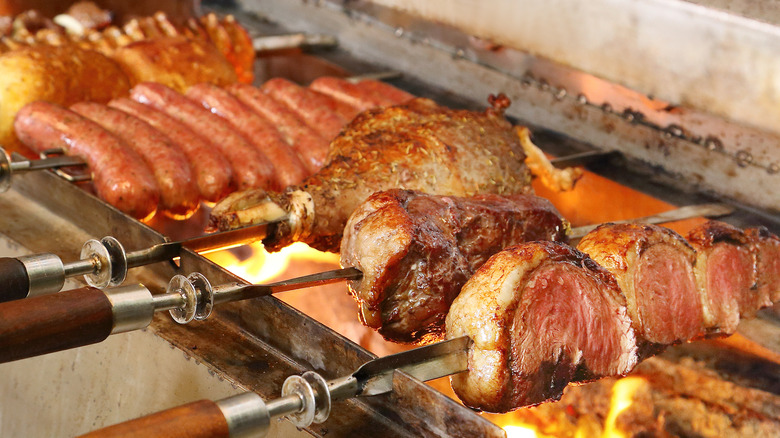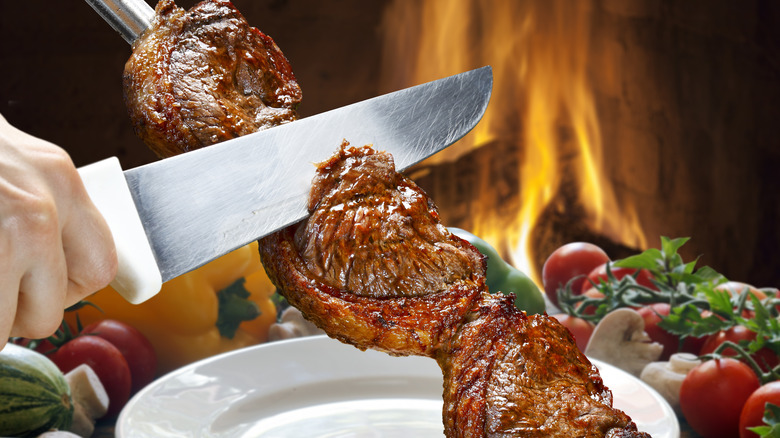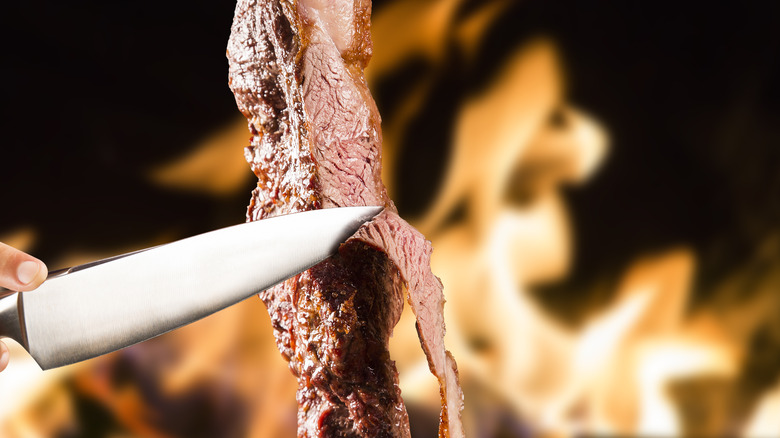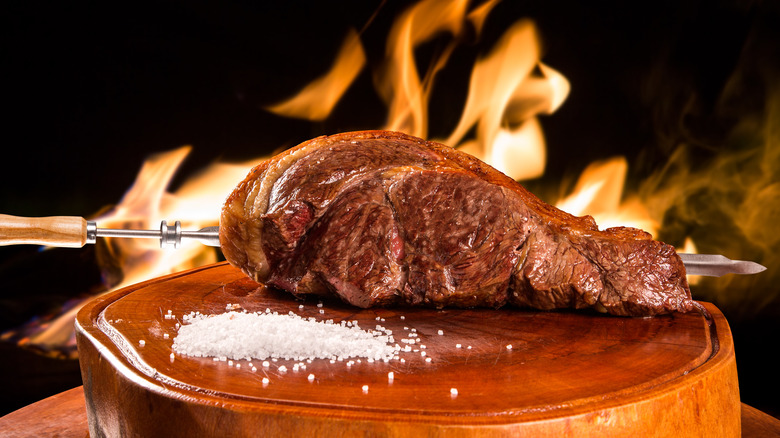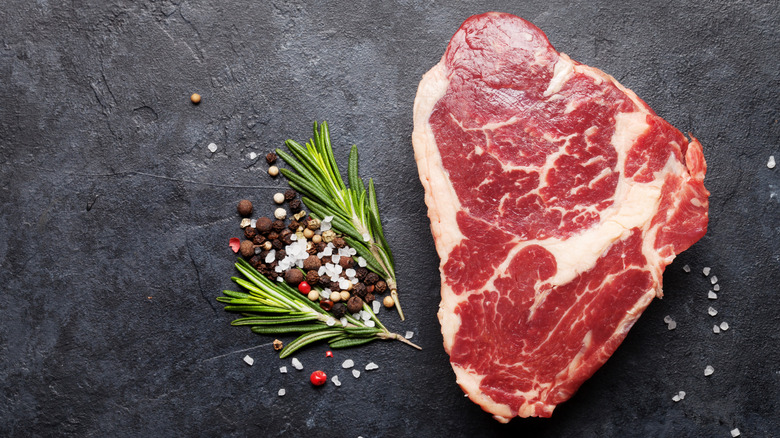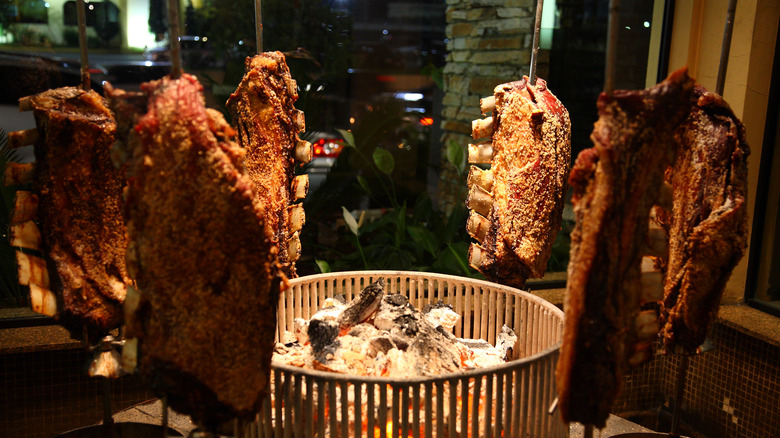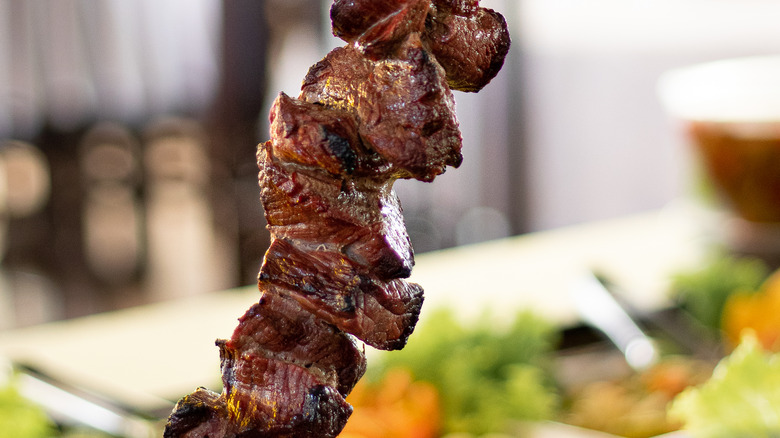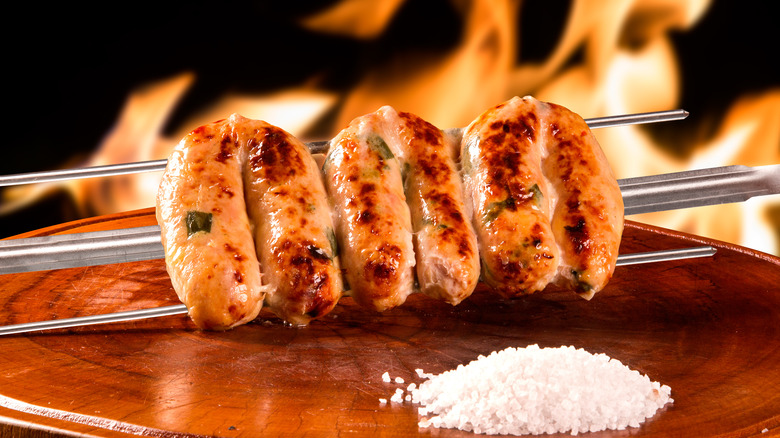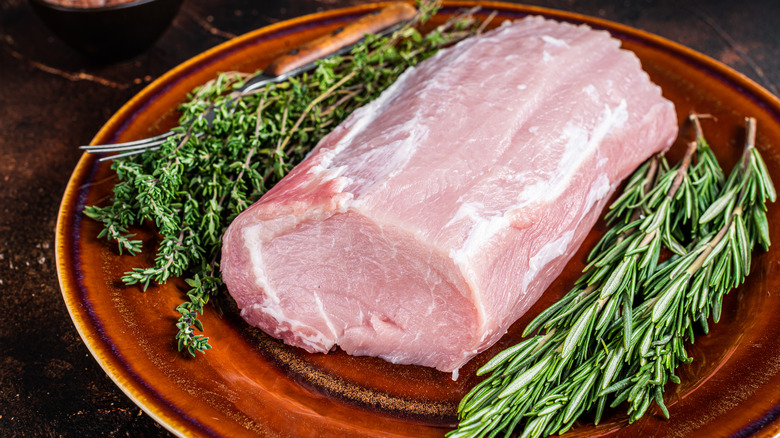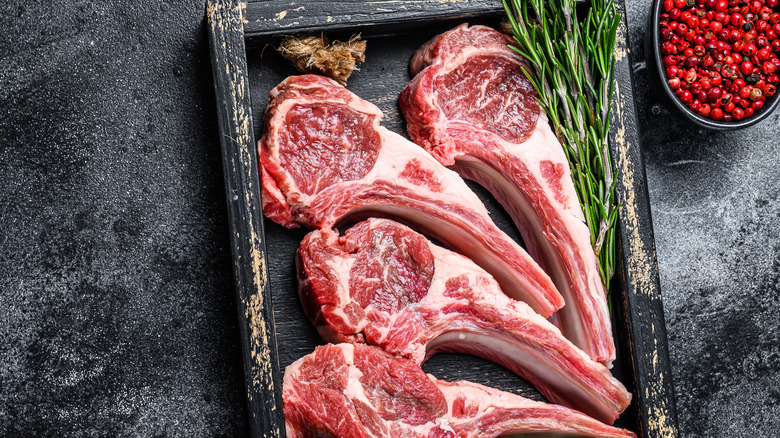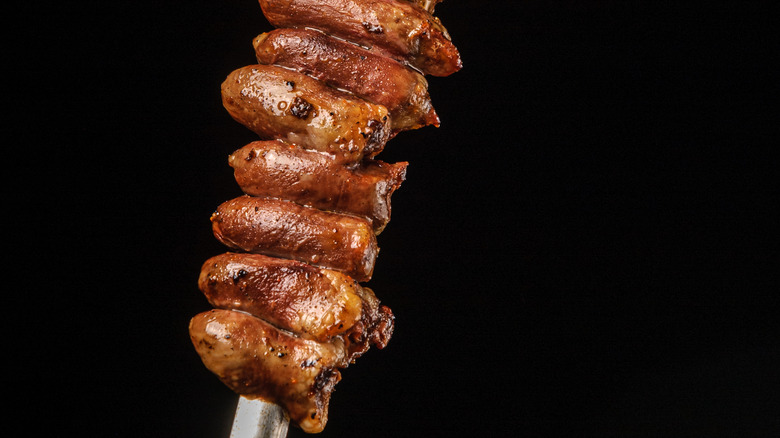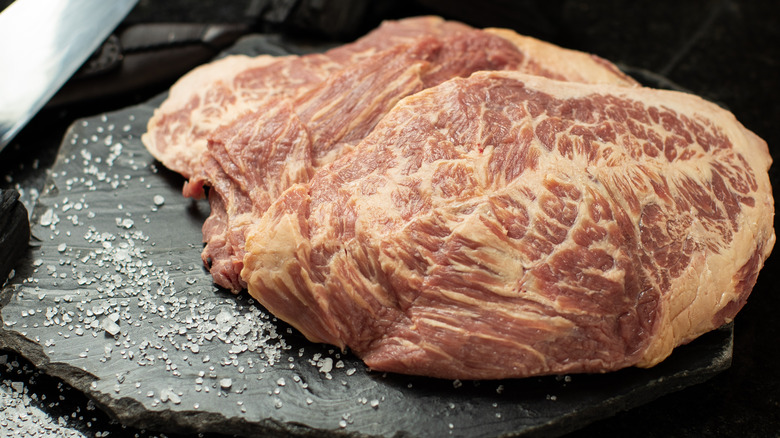Brazilian Steakhouse Meats Explained
Specializing in a type of Brazilian barbeque called churrasco, Brazilian steakhouses are known for bringing skewer upon skewer of juicy barbequed meat straight to your table for the choosing. Churrasco originated as a favorite cooking style of South American cowboys in the 1800s and has since become a beloved part of Brazilian culture and cuisine (via Insider). Meat is barbequed low and slow over the embers of a churrasqueira, an open barbecue grill, and often prepared simply with salt to let the flavors of the meat shine.
But Brazilian steakhouses aren't just about how the meat is cooked, they're also about how it's served — one shaved slice at a time and as much as you can eat. This is called "rodizio," a style of dining where diners pay a fixed price for as much meat as they want. According to Eater, its origin story goes like this: a waiter at a churrascaria in Rio Grande do Sul accidentally delivered a skewer of barbecued meat to the wrong table, but let that guest try a little piece anyway. And easy as that, the rodizio sensation was (allegedly) born!
Apart from being an impressive visual, rodizio-style dining is a great way to sample a variety of different menu items — and there are a lot! From picanha to lombo, we're breaking down the most popular cuts of meat you'll find at a Brazilian steakhouse.
Picanha (rump cap)
Let's start with picanha, the most quintessential cut of meat at a Brazilian steakhouse and a must-have for anyone experiencing a churrascaria for the first time. Picanha, pronounced PEEK-hahn-ya, is a crescent-shaped cut of meat with the fat cap attached (via Steak School) that, when skewered, looks a little like a half medallion. It comes from an animal's hindquarters and is also called the rump cap, rump cover, sirloin cap, or occasionally culotte.
Because it has a fat cap that melts as it cooks, picanha is a tender, juicy cut of meat perfect for slow roasting and often prepared with just a hint of salt. You can find beef, pork, or even lamb picanha depending on the restaurant, but all are solid choices if you want the authentic churrascaria experience.
While you might be hard-pressed to find picanha outside of a Brazilian steakhouse in the United States, the cut is incredibly popular in Brazil and often found at kilo restaurants — a frequent option for lunch similar to the all-you-can-eat buffet except that you pay by the weight of your plate. BBC Close-Up visited a kilo restaurant in São Paulo and put together a classic plate of grilled picanha steak that weighed in at about 5 kilos and cost about $3.50. Now that's a lunch we can get behind!
Fraldinha (bottom sirloin)
Fraldinha is another cut of meat you're likely to find at Brazilian steakhouse. Similar to flank steak, it's served in long, flat pieces with a pink middle and grilled crust. It's cut against the grain to make it as tender and delicious as possible (via Insider). As recommended by Taste Atlas, it's often served with a sharp, vinegary salsa.
Sirloin is typically divided into two cuts: bottom sirloin and top sirloin. Fraldinha is a bottom sirloin. Both are a bit tougher than some other cuts of meat because they come from a more muscular area, making them well-suited to the slow roasting process of Brazilian churrasco.
According to Churrasco Shop, fraldinha was introduced in Brazil by a butcher and restaurateur named Marcos Bassi in 1967. Bassi had a French customer who always requested this cut of meat, then essentially unknown in Brazil, and over time he started to tweak the cut and serve it on a sandwich in sliced, grilled pieces. It was obviously a success, and today fraldinha is a churrasco staple throughout the country.
Alcatra (top sirloin)
Alcatra is the top sirloin to fraldinha's bottom sirloin, the yin to its yang. It's one of the largest skewered cuts served as part of churrasco and is prized for its succulent, hearty beef flavor (via Taste Atlas). Long and lean, this beef cut is seasoned with salt and grilled with a layer of fat that melts away and leaves the remainder crispy and delicious. It's another one you don't want to miss.
Top sirloin makes for great steaks and is a good choice if you're looking for something that's marbled and flavorful while being a bit more on the lean side. It's also very versatile and a good option for making at home, especially if you're shopping on a budget. Next time you're craving a sirloin steak but don't feel like getting out to a Brazilian steakhouse, try this simple recipe for sirloin steak with herb butter and prepare to be impressed with yourself.
Chuleta (ribeye)
If you see chuleta on the menu, you're in for some whole ribeye steaks skewered and grilled (via Insider). Like their name suggests, ribeye steaks come from the rib section of a cow. Butchers can prepare them to be bone-in or boneless and the meat is marbled with a good amount of intramuscular fat that, as MasterClass explains, gives the meat its flavor and moisture.
Speaking of that marbling, we happen to think it makes the ribeye the best cut of steak ever. That's why it's no surprise to us that Kobe, a type of Wagyu beef from Tajima cattle raised in Hyōgo, Japan and one of the most prized types of beef in the world, is a ribeye steak. It's actually pretty rare to find real Kobe, but if you're lucky you might just find Wagyu on the menu of your local Brazilian steakhouse for an extra elevated experience.
Costela (ribs)
Costela translates to ribs, and at a Brazilian steakhouse you'll see skewered slabs of ribs that look like they belong on top of Fred Flintstone's car. As impressive to look at as they are delicious to eat, pork or beef churrasco ribs are a must if you aren't afraid to get a little messy.
James Hills, author of the food and travel blog Mantripping, told Mashed that the perfectly caramelized edges of churrasco ribs give the meat a hint of sweetness, and the benefit to serving them rodizio-style is that it gives you a chance to try them without filling yourself up. "At a regular steakhouse, by the time you get through [a beef rib] it's a lot of fat and heaviness," he explained. "But just a piece of it, it's perfect."
While we're willing to bet the best Brazilian steakhouses aren't making any of the most common mistakes people make when cooking ribs, the rest of us might want to check out some foolproof ways to serve up mouth-watering ribs at home, too.
Filet mignon
This one doesn't need much explanation. While filet mignon is a classic on Brazilian steakhouse menus, pacing yourself enough to fully enjoy your experience is all about priorities. And if we're making a list, we'd actually recommend one of the other cuts to get the most out of your appetite. Why? Favored though it is for its buttery texture (and rightfully so), filet mignon isn't as unique to a Brazilian steakhouse as some of these other meats.
Still, we don't blame you if you can't resist — especially if the filet mignon comes to your table wrapped in bacon, which at a Brazilian steakhouse it often does. This is where the benefits of that rodizio-style dining come in again. You can try as much, or as little, of everything as you like!
Also known as tenderloin steak, filet mignon is lean, tender, and sold boneless. It comes from the area below the backbone, the same area as strip steak, T-bones, and porterhouse steaks, all of which are well-suited to the grill (via Beef. It's What's for Dinner). As reported by CNN Travel, its tenderness and lack of fat make it a favorite among Brazilian churrascarias and it can be delicious when prepared in signature churrasco style.
Linguica (sausage)
Often confused with chorizo but with a milder flavor, linguica (pronounced ling-gwee-suh), is a type of Portuguese sausage commonly served in a Brazilian steakhouse. On the Gas notes that while "linguica" translates literally to "tongue," this sausage isn't made of tongues at all. It's made from ground pork and spices, and the name is simply a reference to its tongue-like shape.
Linguica gets its flavor from spices like garlic, paprika, oregano, and cumin paired with a vinegar brine and smoke curing. The salt and vinegar brine helps mellow out the meaty flavor of the sausage, and it's smoked to make it even more flavorful and tender.
Delighted Cooking notes that linguica is typically made with pork butt, a cut that oddly enough actually comes from the shoulder area. This cut is higher in connective tissue, so turning it into ground pork or sausages or using longer cooking methods is typically best. If you're making pork butt at home (and find yourself without a meat grinder), pulled pork is always an easy win.
Lombo (pork, probably with parm)
While beef gets much of the spotlight at a Brazilian steakhouse, the lombo isn't something to miss, either. The Portuguese word "lombo" translates literally to loin and, on a churrasco menu, most often refers to pork loin served with a crust or sprinkling of Parmesan that lends a smoky, savory flavor.
Pork loin – not to be confused with pork tenderloin — is a cut from between the spine and ribs and often trimmed in a way that leaves a fat cap on the top of the cut (similar to picanha) to help the pork stay moist while it roasts (via Taste of Home). Pork tenderloin, on the other hand, is from above the spine and is more tender because it contains less muscle. Nevertheless, pork loin is better suited to churrasco because it has that fat cap to keep it juicy, while pork tenderloin is more prone to drying out (though if you're making it at home, marinade helps!).
Cordeiro (lamb)
Cordeiro means lamb, and you'll find it at many Brazilian steakhouses in the form of bone-in steaks and chops cut from a rack. As noted by Verywell Fit, lamb is a fairy lean protein with 10 grams of fat per serving. It has a stronger, more gamey flavor than beef, pork, or chicken, a direct result of the time an animal spends grazing at pasture, and stands up well to bold spices and char from the grill (via Kitchn).
If you try lamb next time you're at a Brazilian steakhouse and want to recreate part of the experience at home, it's easier than you might think to make an almost-as-impressive rack yourself. Just follow this recipe from Christina Musgrave at Tasting with Tina. It only takes 35 minutes from prep to plate, but makes it look like you spent all day in the kitchen. You can even cut some of the gaminess with a simple soak in milk.
Frango (chicken)
Frango is Portugese for chicken, and many Brazilian steakhouses have some version of it on the menu. Options range from bacon-wrapped chicken breasts to sweet and sour marinated drumsticks, all served on skewers of course. Tasty options yes, but we wholeheartedly support the steak when you're at a Brazilian steakhouse. As Mantripping's James Hill put it to Mashed, "I never get the chicken; chicken is not what I'm going to spend my appetite budget on."
That said, there are some chicken options very authentic to the churrasco experience. Take coração de frango, for example. You won't find it on every Brazilian steakhouse menu, but, if you do, you'll see chicken hearts grilled in classic churrasco style among the skewers brought to your table. If you don't know what they are, you might mistake them for short sausages.
According to food blogger Brazilian Kitchen Abroad, coração de frango is a classic appetizer of the authentic churrasco experience and tastes similar to dark meat chicken, just a little chewier and sweeter with a bit of a metallic tang.
Cupim (beef hump)
Last but certainly not least, we have cupim. Pronounced ku-pin, this isn't a cut you're very likely to see in the United States. That said, we included it on this list because it's so unique to Brazilian cuisine (and hey, you might just get lucky, or find yourself at a Brazilian steakhouse actually in Brazil). Cupim comes from a special breed of cow called the Brazilian Zebu that, unlike the cows we're most used to seeing here, have a hump between their shoulder blades much like a camel (via The Cattle Site). That hump is where cupim comes from.
Tender, rich, and marbled, Taste Atlas explains that cupim has no blood or juice and, when eaten, is described as rich and fatty with a bit of a stringy texture. Popular YouTuber Sous Vide Everything recommends treating cupim similar to brisket and using a cooking method that helps tenderize the slightly tough cut of meat. He also points out that too much liquid can dilute the flavor of cupim — not a problem when it's cooked churrasco style! So, if you do come across this unique cut of meat, we definitely recommend giving it a try.
